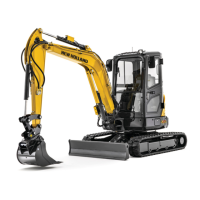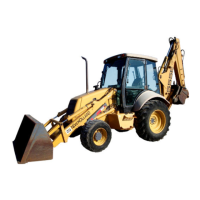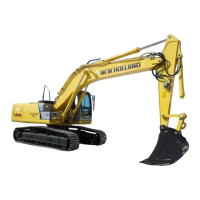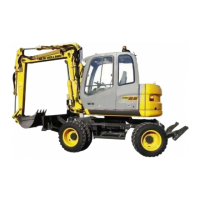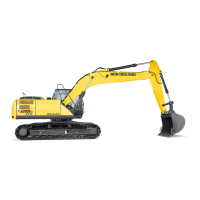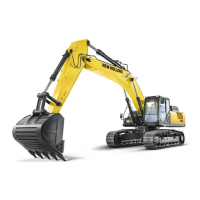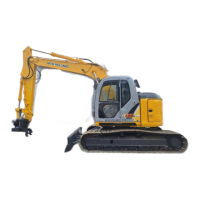Do you have a question about the New Holland Kobelco E265B and is the answer not in the manual?
General information about the manual's content and usage.
Information on scheduled service inspections provided by the dealer.
Statement regarding product improvements and changes without notice.
Instructions on where to store the manual for easy access.
Information on what details are needed when ordering parts or service.
Explains safety alert symbols, signal words, and general safety principles.
Basic precautions for operation, maintenance, and repair to avoid injury.
Illustrates warning labels and decals with their locations on the machine.
Safety checks and precautions before starting the machine.
Safety measures to be followed while operating the machine.
Safety procedures for performing inspection and maintenance.
Precautions related to handling and charging batteries safely.
Examples of machine abuse and misuse that should be avoided.
Procedures to follow at the end of each work shift for machine safety.
Safety instructions and procedures for towing the machine.
Identifies and labels major machine components in an illustration.
Identifies and labels controls and components within the operator's cab.
Describes the function of various components and controls.
Explains the gauges, switch panels, and multi-display functions.
Details the location of various switches and meters in the operator's cab.
Describes the function and operation of control levers and pedals.
Explains the location and replacement procedure for fuses.
Details the fusible link for the starter system.
Locates and describes the function of the controllers.
Instructions for handling the machine's antenna.
Description and operation of the air conditioning system.
Instructions on how to fasten and unfasten the seat belt.
Describes the various adjustment mechanisms for operator comfort and safety.
Details how to adjust the arm rests.
Explains the functions of the operator cab features like door locks and sunroof.
Information on the fuel pump location and filling procedure.
Procedures for safely escaping the cab in an emergency.
Describes additional equipment like tool box and cup holder.
General overview of machine operation.
Daily inspection procedures before starting the engine.
Checks for coolant and oil levels before initial startup.
Instructions for adjusting the operator's seat for comfort and safety.
Procedure for adjusting mirrors for optimal visibility.
Steps to verify the functionality of the gauge cluster.
Procedure to check the operation of work lights.
Step-by-step guide for starting the engine.
Procedures for safely stopping the machine's engine.
Checks to perform after the engine has started.
Procedures for warming up the engine and hydraulic oil.
Explanation of how to select different work modes.
Description of the control layout and decal information.
General instructions for operating the machine.
Tips and techniques to enhance operational efficiency.
Standard hand signals used by flagmen for excavator operations.
Procedures for safely parking the machine.
Steps to take after completing machine operation.
Operating guidelines for extreme cold, heat, and high altitudes.
General advice and recommendations for maintenance.
Safety rules and precautions for performing maintenance.
Table detailing required lubricants, fuels, and coolants.
Information and precautions for using biodegradable oils.
List of common maintenance parts and their replacement intervals.
Table of torque specifications for various bolts and nuts.
Detailed torque values for metric coarse and fine threads.
Torque values for specific joints and hydraulic hoses.
Schedule of recommended inspection and maintenance intervals.
Maintenance tasks that need to be performed as needed.
Daily inspection and maintenance procedures.
Weekly inspection and maintenance tasks.
Maintenance procedures at 120-hour intervals.
Maintenance procedures at 250-hour or 3-month intervals.
Maintenance procedures at 500-hour intervals.
Maintenance procedures at 1000-hour or 12-month intervals.
Maintenance procedures at 2000-hour intervals.
Maintenance procedures at 5000-hour intervals.
Procedures and considerations for transporting the machine on the ground.
Steps to prepare the machine for transportation.
Instructions and safety for loading and unloading the machine.
Methods for securely fixing the machine during transport.
Procedures for safely lifting the machine.
Instructions for installing and removing mirrors for transport.
Technical data and dimensions of the machine.
Details on different crawler shoe types and their specifications.
Specifications for digging reach and depth for different attachments.
Information on compatible bucket and arm combinations.
General information on operating hydraulic breakers and nibblers.
Guidance on selecting the optimal breaker or nibbler.
Pre-operation checks and consultation for breakers/nibblers.
Measures to prevent contamination during attachment changes.
How to select work modes and use the selector valve.
Instructions for setting the stop valve for hydraulic oil flow.
Information on adjusting flow rate for breakers.
Basic operational principles for breakers and nibblers.
Safety precautions and prohibited operations when using a breaker.
Maintenance intervals for hydraulic oil and filters with attachments.
Information on reinforcing the arm for attachments.
Safety precautions and prohibited operations when using a nibbler.
Guidelines for using breakers from different manufacturers.
General information about the manual's content and usage.
Information on scheduled service inspections provided by the dealer.
Statement regarding product improvements and changes without notice.
Instructions on where to store the manual for easy access.
Information on what details are needed when ordering parts or service.
Explains safety alert symbols, signal words, and general safety principles.
Basic precautions for operation, maintenance, and repair to avoid injury.
Illustrates warning labels and decals with their locations on the machine.
Safety checks and precautions before starting the machine.
Safety measures to be followed while operating the machine.
Safety procedures for performing inspection and maintenance.
Precautions related to handling and charging batteries safely.
Examples of machine abuse and misuse that should be avoided.
Procedures to follow at the end of each work shift for machine safety.
Safety instructions and procedures for towing the machine.
Identifies and labels major machine components in an illustration.
Identifies and labels controls and components within the operator's cab.
Describes the function of various components and controls.
Explains the gauges, switch panels, and multi-display functions.
Details the location of various switches and meters in the operator's cab.
Describes the function and operation of control levers and pedals.
Explains the location and replacement procedure for fuses.
Details the fusible link for the starter system.
Locates and describes the function of the controllers.
Instructions for handling the machine's antenna.
Description and operation of the air conditioning system.
Instructions on how to fasten and unfasten the seat belt.
Describes the various adjustment mechanisms for operator comfort and safety.
Details how to adjust the arm rests.
Explains the functions of the operator cab features like door locks and sunroof.
Information on the fuel pump location and filling procedure.
Procedures for safely escaping the cab in an emergency.
Describes additional equipment like tool box and cup holder.
General overview of machine operation.
Daily inspection procedures before starting the engine.
Checks for coolant and oil levels before initial startup.
Instructions for adjusting the operator's seat for comfort and safety.
Procedure for adjusting mirrors for optimal visibility.
Steps to verify the functionality of the gauge cluster.
Procedure to check the operation of work lights.
Step-by-step guide for starting the engine.
Procedures for safely stopping the machine's engine.
Checks to perform after the engine has started.
Procedures for warming up the engine and hydraulic oil.
Explanation of how to select different work modes.
Description of the control layout and decal information.
General instructions for operating the machine.
Tips and techniques to enhance operational efficiency.
Standard hand signals used by flagmen for excavator operations.
Procedures for safely parking the machine.
Steps to take after completing machine operation.
Operating guidelines for extreme cold, heat, and high altitudes.
General advice and recommendations for maintenance.
Safety rules and precautions for performing maintenance.
Table detailing required lubricants, fuels, and coolants.
Information and precautions for using biodegradable oils.
List of common maintenance parts and their replacement intervals.
Table of torque specifications for various bolts and nuts.
Detailed torque values for metric coarse and fine threads.
Torque values for specific joints and hydraulic hoses.
Schedule of recommended inspection and maintenance intervals.
Maintenance tasks that need to be performed as needed.
Daily inspection and maintenance procedures.
Weekly inspection and maintenance tasks.
Maintenance procedures at 120-hour intervals.
Maintenance procedures at 250-hour or 3-month intervals.
Maintenance procedures at 500-hour intervals.
Maintenance procedures at 1000-hour or 12-month intervals.
Maintenance procedures at 2000-hour intervals.
Maintenance procedures at 5000-hour intervals.
Procedures and considerations for transporting the machine on the ground.
Steps to prepare the machine for transportation.
Instructions and safety for loading and unloading the machine.
Methods for securely fixing the machine during transport.
Procedures for safely lifting the machine.
Instructions for installing and removing mirrors for transport.
Technical data and dimensions of the machine.
Details on different crawler shoe types and their specifications.
Specifications for digging reach and depth for different attachments.
Information on compatible bucket and arm combinations.
General information on operating hydraulic breakers and nibblers.
Guidance on selecting the optimal breaker or nibbler.
Pre-operation checks and consultation for breakers/nibblers.
Measures to prevent contamination during attachment changes.
How to select work modes and use the selector valve.
Instructions for setting the stop valve for hydraulic oil flow.
Information on adjusting flow rate for breakers.
Basic operational principles for breakers and nibblers.
Safety precautions and prohibited operations when using a breaker.
Maintenance intervals for hydraulic oil and filters with attachments.
Information on reinforcing the arm for attachments.
Safety precautions and prohibited operations when using a nibbler.
Guidelines for using breakers from different manufacturers.
| Brand | New Holland |
|---|---|
| Model | Kobelco E265B |
| Category | Excavators |
| Language | English |

